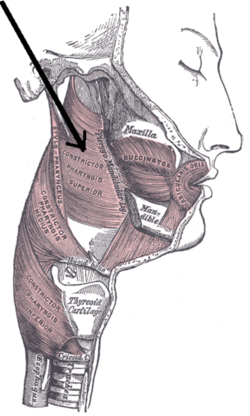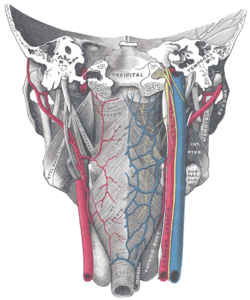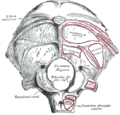- Superior pharyngeal constrictor muscle
-
Superior pharyngeal constrictor muscle Muscles of the pharynx and cheek. Muscles of the pharynx, viewed from behind, together with the associated vessels and nerves. Latin musculus constrictor pharyngis superior Gray's subject #244 1143 Origin medial pterygoid plate, pterygomandibular raphé, alveolar process Insertion pharyngeal raphe, pharyngeal tubercle Artery Ascending pharyngeal artery and tonsillar branch of facial artery Nerve Pharyngeal plexus of vagus nerve Actions Swallowing The superior pharyngeal constrictor muscle is a quadrilateral muscle, thinner and paler than the inferior pharyngeal constrictor muscle and middle pharyngeal constrictor muscle.
Contents
Origin and insertion
The four parts of this muscle arise from:
- the lower third of the posterior margin of the medial pterygoid plate and its hamulus (Pterygopharyngeal part)
- from the pterygomandibular raphe (Buccopharyngeal part)
- from the alveolar process of the mandible above the posterior end of the mylohyoid line (Myolopharyngeal part)
- and by a few fibers from the side of the tongue (Glossopharyngeal part)The fibers curve backward to be inserted into the median raphe, being also prolonged by means of an aponeurosis to the pharyngeal spine on the basilar part of the occipital bone.
The superior fibers arch beneath the levator veli palatini muscle and the Eustachian tube.
Relations
The interval between the upper border of the muscle and the base of the skull is closed by the pharyngeal aponeurosis, and is known as the sinus of Morgagni.
Action
As soon as the bolus of food is received in the pharynx, the elevator muscles relax, the pharynx descends, and the constrictors contract upon the bolus, and convey it downward into the esophagus.
Innervation
The superior pharyngeal constrictor muscle is innervated by the pharyngeal branch of the vagus nerve via the pharyngeal plexus.
Additional images
External links
- 26869838 at GPnotebook
- LUC scon
- lesson8 at The Anatomy Lesson by Wesley Norman (Georgetown University) (latpharyngealitems3)
- Roche Lexicon - illustrated navigator, at Elsevier 05287.011-1
This article was originally based on an entry from a public domain edition of Gray's Anatomy. As such, some of the information contained within it may be outdated.
List of muscles of head and neck: the neck (TA A04.2, GA 4.387) Cervical Suboccipital Suprahyoid CN V3 (medial): mylohyoid · anterior belly of digastric
CN VII (lateral): stylohyoid · posterior belly of digastric
C1 (deep): geniohyoidInfrahyoid/strap Fasciae Pharynx pharyngeal constrictor (superior, middle, inferior) · longitudinal (stylopharyngeus, salpingopharyngeus)Larynx cricothyroid · cricoarytenoid (posterior, lateral) · arytenoid (oblique arytenoid/aryepiglottic, transverse arytenoid) · thyroarytenoid (vocal, thyroepiglottic)Categories:- Muscle stubs
- Muscles of the head and neck
Wikimedia Foundation. 2010.






